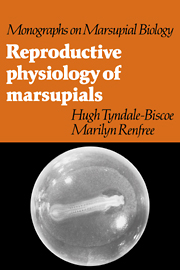Book contents
- Frontmatter
- Contents
- Preface
- 1 Historical introduction
- 2 Breeding biology of marsupials by family
- 3 Sexual differentiation and development
- 4 Male anatomy and spermatogenesis
- 5 The female urogenital tract and oogenesis
- 6 Ovarian function and control
- 7 Pregnancy and parturition
- 8 Lactation
- 9 Neuroendocrine control of seasonal breeding
- 10 Marsupials and the evolution of mammalian reproduction
- References
- Index
4 - Male anatomy and spermatogenesis
Published online by Cambridge University Press: 06 January 2010
- Frontmatter
- Contents
- Preface
- 1 Historical introduction
- 2 Breeding biology of marsupials by family
- 3 Sexual differentiation and development
- 4 Male anatomy and spermatogenesis
- 5 The female urogenital tract and oogenesis
- 6 Ovarian function and control
- 7 Pregnancy and parturition
- 8 Lactation
- 9 Neuroendocrine control of seasonal breeding
- 10 Marsupials and the evolution of mammalian reproduction
- References
- Index
Summary
Reproduction in the male marsupial has been less well studied than reproduction in the female, perhaps because there are fewer obvious differences between marsupial and eutherian patterns in this sex. However, on closer scrutiny, many unique features emerge, including, as in the female, the anatomy of the genital tract. As Edward Tyson wrote when introducing Cowper's (1704) paper – ‘the organs of generation in the male are no less surprising and remarkable than in the female; and in both they are different from any other animal that I have met with’ (Fig. 1.1).
Anatomy and physiology of the male genitalia
The genital tract consists of paired testes, epididymides and vasa deferentia which open into the anterior end of the large prostate gland. A thin membraneous urethra extends from the posterior end of the prostate, and bulbo-urethral (or Cowper's) glands are present (Figs 4.1 and 4.2). There are no seminal vesicles, ampullae or coagulating glands. The only apparent exceptions to this are found in Caenolestes obscurus (Rodger, 1982)and in Burramysparvus(P. D. Temple-Smith,unpublished), which each have a convoluted secretory segment of the distal portion of the vas, which resembles the eutherian ampulla. The glans penis is cleft in some species, and the scrotum is anterior to the penis in all species (Stirling, 1891; Sweet, 1907).
The scrotum, testes and epididymides
The testes of adult marsupials are generally ellipsoid in shape, (Setchell, 1977) and, in all except two fossorial species, are permanently scrotal.
- Type
- Chapter
- Information
- Reproductive Physiology of Marsupials , pp. 124 - 171Publisher: Cambridge University PressPrint publication year: 1987
- 1
- Cited by



